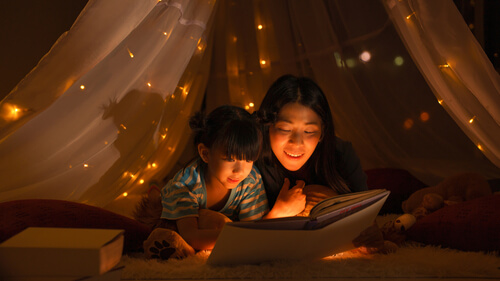
The Hygge approach, pronounced ‘huga’, is a Danish lifestyle that has become popular worldwide in recent years. It’s about finding wellbeing through enjoying the simple things in life and living in the moment. It’s typically associated with cosiness (think a hot cup of tea after a bracing autumnal walk), and Christmas is the ultimate time for hygge, but can be practised all year round. Some early years settings are becoming a hygge nursery to enhance children’s wellbeing and learning by encompassing its principals into the nursery’s environment and activities.
What is a hygge nursery?
Hygge nurseries support children’s wellbeing and development by using the hygge ethos of living in the moment and embracing life’s simple pleasures. Any nursery can adopt this approach alongside their main curriculum. They can then achieve hygge accreditation; other early years settings and childminders can also be accredited.
A hygge nursery incorporates the ten core elements of hygge into its approach. These are:
- Atmosphere – creating a warm, calm and homely atmosphere
- Presence – focus on what they are doing and feeling right here, right now
- Pleasure – activities that are fun and promote happiness and wellbeing
- Equality – sharing and respect for others
- Togetherness – spending quality time together and forming strong friendships
- Gratitude – time to reflect and discuss what they’re grateful for
- Harmony – less focus on competitiveness and instead enjoying playing together
- Truce – learning to play fairly and manage conflict
- Comfort – a comfortable, cosy environment
- Shelter – space to relax or read alone
These elements are achieved through careful changes to the children’s environment and the team’s approach to learning.
The hygge environment
- Mood lighting, twinkling lights and LED candles
- Calming music
- Calming scents
- Bringing nature indoors – real and artificial plants, as well as natural materials like wood, wicker, pebbles, pinecones, conkers, sand and water
- Homely decorations and areas – armchairs, blankets, cushions, curtains, lamps, framed pictures and mirrors
- Carpets, rugs and other soft furnishings to help reduce noise
- Dens, nests, teepees and cosy corners
- Minimal use of artificial lights
- Minimal clutter
Hygge in practice
- Emphasis on calm and warmth in teaching and interacting with children
- Lots of time and space to sit and talk
- Activities exploring:
- Nature, inside and outside
- The environment
- Self-care
- Simple pleasures like baking a cake, planting a seed or reading a book
How does Hygge approach help children with wellbeing and development?
Using the hygge approach in early years settings has shown to have a number of benefits to children, including:
- Providing a safe, cosy environment that feels like their own home
- Supporting calm, peaceful play that can help them to manage their emotions
- Encouraging children to explore and appreciate nature and natural materials
- Promoting friendship and self-confidence
- Plenty of cosy dens and nooks allow children privacy to wind-down or explore their own interests
Edgbaston Nursery & Preschool, in Birmingham, has successfully adopted the hygge approach. To nursery manager Zareen Rashid, the positive effects of hygge on children’s learning have been clear.
She says: “The use of mood lighting and calm music has had a positive effect on the children. We notice that they seem to be more focused when engaged in their play and show more concentration as the atmosphere is relaxing and calming. Playing calming music when children enter the room seems to encourage a positive mood which continues into the rest of the day.”
Ms Rashid has even noticed babies reacting well to the hygge environment, in particular the baby spa, which has carefully chosen sounds, scents, colours and materials. She explains: “We noticed almost immediately that the babies and toddlers were much calmer when using the area. Time is taken to allow the children to take in the atmosphere, not rushing the process when using the room and encouraging children to take in their surroundings, talking about what they can see and smell. The children have responded to the calming music, lights and smells positively and we can tell that they now anticipate the nappy changing process with excitement.”


